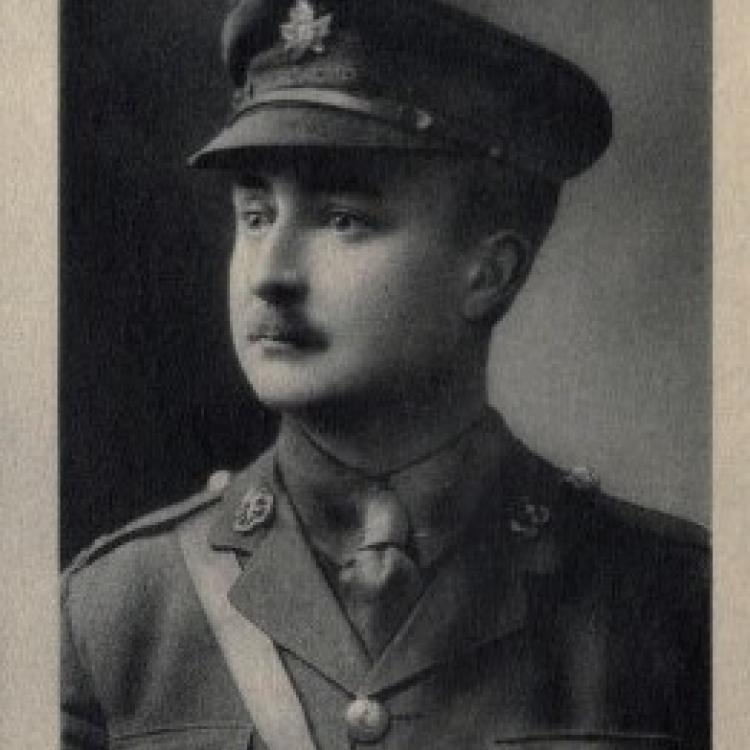ELIOT, Lionel Hyman
RANK: Lieutenant
DIVISIONAL UNIT: 4th Canadian Infantry Division
11th Infantry Brigade
75th Battalion - Mississauga
Canadian Infantry Corps
SERVICE NO: 451765
RESIDENCE: Goderich – Ontario
DATE OF BIRTH: September 16, 1887
London – Middlesex County - Ontario
DATE OF DEATH: April 9, 1917 29 years 6 months
CEMETERY: Canadian Cemetery No. 2 – Neuville-St. Vaast –
Pas de Calais – France
I A 4
PARENTS: Mr. William and Mrs. Anna Eliot – London - Ontario
Occupation: Bank Clerk –
Bank of Hamilton Religion: Anglican
Enlistment: London – June, 1915 into 58th Battalion
Enlistment Age: 27 years 9 months
While attending Goderich Collegiate Institute “Leo” played on a number of sport teams, was active in the drama club and literary society.
Lieutenant Eliot departed Canada on the S.S. Empress of Britain on March 29, 1916 and arrived in England on
April 9, 1916. From May 14th to the second week in June he attended various courses. He proceeds to the 60th Battalion and continues to take various courses. Then in early October he proceeds overseas to the 75th Battalion.
Lieutenant Eliot while advancing with his men took cover in a shell hole. He was taking aim to put an enemy sniper out of commission when he himself was struck in the head from a bullet and died instantly. He was found lying with members of his platoon, their heads towards an enemy strong-point. His Battalion had suffered heavily.
Lionel was born in London and upon completing his education he was employed by the Bank of Hamilton.
After his enlistment he worked hard and was promoted rapidly, and in August of 1915 was given his commission as Lieutenant and attached to the 75th Battalion. He and his unit arrived in France in October of 1916 and immediately went to the Somme where he served with distinction.
The weather was rather misty with a slight rain
The Battalion was to advance in four waves with “A” Company on the right - “C” Company on the left. They were followed by “B” right and “D” left. Each Company would have a front of three half platoons.
No. 1 Platoon was to establish an outpost and then connect with the 54th Battalion right and No. 2 Platoon left. The Billy Biff Bess Trench was their guide. No. 2 would advance and be guided by the railway establishing an outpost near Banff-Beano Trench. No. 3 Platoon would advance using the Beano Trench as their guide and establish outposts in Banff Trench. No. 5 Platoon following the barrage map up Beer Trench between Beano/Bess Trenches and then establish a connection with the 54th Battalion on the right. No. 6 Platoon will mop up and establish a strong point at the corner of Beano / Beer Trenches. No. 7 Platoon will advance and mop up Beer Trench between Beano / Basin Trenches and make contact on the left with 5 Platoon. Platoons 9 / 10 / 11 following the barrage advance along Beano Trench and establish outposts in the area. No. 13 Platoon following the barrage will advance along Basin Trench and establish outposts near the junction of Cyclist / Basin Trenches. No. 14 Platoon following the barrage will advance along Basin Trench and establish outposts near the corner of Basin / Banff Trenches.
Officers were to be responsible to make sure that strong patrols would be sent out in each forward direction but especially toward Givenchy to the north.
The barrage prior to the attack was very good and the advance began at 5:30 am. An enemy strong point directly in front of Tottenham Trench had not been cleared out and casualties from enemy snipers were considerable. At 1pm a group of 12 men started from a point immediately in front of Tottenham Trench with the goal of bombing down the enemy to the right. By 3pm the enemy front lines were clear.
The death of Lieutenant Eliot became a symbol of the sacrifices made by Canadians. Two days following the Canadian victory at Vimy Ridge, His Majesty King George V visted Vimy Ridge and paused in front of the grave of Lieutenant Eliot. While looking at the grave His Royal Highness bowed his head in reverence.



